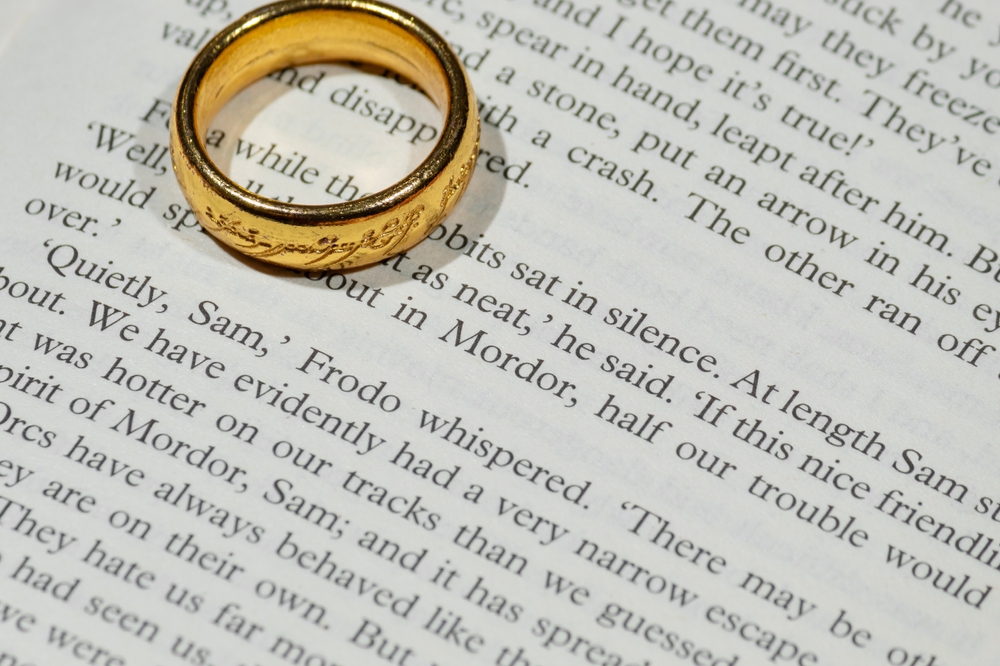For his creation of Middle-earth, drenched in cultural and linguistic inventiveness, and rich in theological undertones, J.R.R. Tolkien is deservedly credited as one of the first and best creators of the modern fantasy genre. In Tolkien: Philosopher of War, Graham McAleer makes the case that this is not just a literary accomplishment, but that Tolkien should be recognized as a serious thinker concerning warfare and its place in the greater narrative of human history.
The book offers an unusual and extremely thought-provoking assessment of Tolkien’s work, developing links between his views of aesthetics, theology, history, philosophy, and strategy. McAleer uses a range of authors as foils or lenses through which to assess Tolkien’s work, including Christopher Dawson, Halford Mackinder, David Hume, Eric Voegelin, and Carl Schmitt. McAleer’s Tolkien emerges as an unorthodox thinker defined by his refusal to elevate human beings above their real natures—and especially by his deference to the cosmos we inherit.
While this book presents a compelling account of what Tolkien thought about war, McAleer makes an even stronger case for Tolkien’s depth as a conservative and postliberal thinker steadfastly opposed to progressive philosophies of history. History is “a matter of vanity. Worldly endeavors end in defeat, and it is vanity to think otherwise.” But just as in Ecclesiastes, the world’s tendencies toward vanity do not in any way absolve us from defending the good in our ordinary life, in our politics, and, at the extreme, in war, for “war touches the things we cherish and fear: life and land, building and belonging, subversion and possession, plunder and justice, and anger and mercy.”
McAleer cites a remarkable comment Tolkien offered about these matters at the end of World War II:
There is a stand-down parade of Civil Defence in the Parks in the afternoon, to which I shall prob. Have to drag myself. But I am afraid it all seems rather a mockery to me, for the War is not over (and the one that is, or the part of it, has largely been lost). But it is of course wrong to fall into such a mood, for Wars are always lost, and The War always goes on; and it is no good growing faint!
Even a “good war” ends in a certain sort of defeat, with much that should have been cherished lost, and many promising lives cut short. But in his view, the struggle is one against evil itself—and one we all must endure. The Lord of the Rings and Tolkien’s other works stand as reminders of what it means to think seriously about the defense of civilization.
From the outset we can see that Tolkien did not shy away from presenting war’s violence and horror; but he went further, exploring a truth about the human condition many are reluctant to admit: “Some of the most loveable characters are, it is undeniable, enthusiastic about war. Gimli and Legolas relish combat and even Treebeard, once angered enough about the destruction of the trees, savors revenge, embracing a war of annihilation against his enemies.” Convinced that such violence could vindicate justice, Tolkien used highly moral language throughout his works to describe civilization’s enemies, but McAleer highlights Tolkien’s use of aesthetic judgment as well. The orcs are not simply evil; they evoke disgust. He highlights an exchange in The Two Towers between Sam and Frodo that places orcish tastes beyond the pale (perhaps even to cannibalism): “Orcs drink, don’t they?” “Yes, they drink,” said Frodo. “But do not let us speak of that. Such drink is not for us.”
McAleer contends that Tolkien’s strong aesthetic sense that beauty and goodness oppose evil and horror is tied to his “sober philosophy of history,” one driven by man’s “incomplete knowledge.” He contrasts this to fascism and futurism, the movements that gave birth to World War II, which he argues are allied forms of Gnosticism, united in their revolt against the cosmos.
McAleer via Tolkien traces this sense of refusing reality—this vanity—back to the Enlightenment’s desire to liberate men from all restraint, including that of nature. As a consequence, “War is hard-wired into the Enlightenment,” argues McAleer, because its philosophies of history all trade on vanity.” Enlightenment powers must always strive to transform the world, in part because if they were to stop, they would realize the futility of their efforts. Tolkien’s postliberalism is an exposé: All history is a false promise, perhaps especially the liberatory philosophies of the Enlightenment. We are not on a march toward perpetual peace, and war will always be with us.
Characters throughout the books, ranging from the Galadriel of The Silmarillion to Saruman and Sauron in Lord of the Rings, embody this revolt and its desire to divinize man and spread false hope in secular transformation. McAleer argues that they—and most of the West—remain in at least partial thrall to the “speculative history” that emerged in our consciousness during the Enlightenment. Apart from those who retain a theological view of time, it is thinkers such as Leibniz, Smith, Hume, Hegel, and Marx who shape today’s popular view of history’s scope and character. McAleer suggests that most of us are Whiggish Hegelians now, inhabiting a world convinced of History’s bias toward progress, whether we consciously think in these terms or not.
Tolkien: Philosopher of War places Tolkien in fruitful conversation with many writers, but none provokes more questions and thinking than the one with Carl Schmitt. Developed in works like The Concept of the Political, Schmitt’s infamous view that politics is defined by the friend-enemy distinction has influenced postliberals of both the left and the right in recent years. McAleer frames Schmitt’s insights around his later work and in particular the concept of the “manring,” which he argues appears throughout Tolkien’s sagas. McAleer explains the manring as the community’s enforcing of boundaries within and without to protect civilization: “The life of a place requires a preparedness to protect that home. Solidarity requires a solidification of the enclosure.”
McAleer argues that the right way to understand Schmitt is to see his politics of friends and enemies in narrower terms—this is an insight that pertains more to war than to peace. In McAleer’s view, Schmitt helps us see what a community attuned to this politics will know:
A genuinely political people are ever sensitive to existential threat, to grasping that they may be conquered, and their way of life destroyed. … An enemy is one who threatens a way of life. Threats, disputes, and events that do not rise to this level are not grounds for war.
Everything hinges on what we view as a genuine threat to our way of life. In the context of the War of the Ring, Middle-earth’s many free peoples faced exactly such a threat. McAleer makes a compelling case that Tolkien at least partially resonates with Schmitt’s understanding, but does so in a manner that utterly rejects Schmitt’s “value minimalism.” Tolkien’s fable frames the definition of friendship and enmity through explicitly moral and aesthetic language and acceptance of the cosmos—something it is unclear Schmitt ever did. The use of Schmitt to help grasp Tolkien slightly distracts from the moral and theological core of Middle-earth. But it is one of several references that McAleer uses to deepen the reader’s understanding of what he sees as Tolkien’s Tory postliberalism.
McAleer also points to the strategist Halford Mackinder, whose understanding of geography’s constraints on world history partially align with Tolkien’s own. For Mackinder and Tolkien both, the physical constraints and possibilities of the land, how it is used and cultivated, are literally the stuff of civilizations. But Tolkien departs from Mackinder on a crucial point: The latter primarily “derives history from nature, land being near-deterministic,” whereas Tolkien retained a deeper sense of providential hope—one embodied in the strange providence of the Ring falling into Bilbo’s and then Frodo’s hands.
Tolkien would have none of the modern pretension that history could sweep away constraint and was equally against modernity’s various mechanical determinisms. He abhorred something he called “Americo-cosmopolitanism,” which he opposed to his own deep love of England. McAleer attempts to explain this through a contrast between two images of the city, one that fits our own society’s view, which echoes Hume, who “argues that civilization relies on the intimate relationship between commerce and refinement in the arts and sciences.” Contrast this with Tolkien’s view, as seen in the various cities of Middle-earth:
Middle-earth has its share of magnificent cities but, interestingly, in LotR they are mostly marked by decay. Gondolin was long ago overrun by Orcs, Osgiliath is in ruins, Dwarrowdelf a tomb, Rivendell is emptying, and the White City sparsely populated.
At stake here is the understanding of what matters and is worth defending in war. In Tolkien’s imagination, cities are places of decadence and commerce rather the real sources of civilization. They rely too much on the “allure of fashion, opulence, and vanity,” and represent—at least until their decline—something of a constant acceleration to human life.
In contrast to the aggressive energy unleashed by commercial society, Tolkien emphasizes the love of an inherited place as what Middle-earth’s heroes fight to protect. These are people who live for something handed down to them and love it, going forth against their preferences and character to war in its defense. McAleer suggests that Tolkien is acutely aware of how our world places a wedge between our inheritance and our current prosperity, as markets tend to erode our attachments to home and shatter the ties of history. But it is inheritance that rules in Tolkien’s world:
The eccentricities of Bilbo, Éowyn, and Bombadil, to name only a few, are a way for Tolkien to stress how an inherited identity enhances rather than smothers. To fight for one’s land is, implies Tolkien, to fight for personhood.
Other forms of inheritance matter, too: To the degree that Tolkien presents hints of markets and commerce in his stories, it is craftsmanship that is most prominent. Although McAleer does not explicitly draw this out, Tolkien’s views bear some resemblance to the Anglo-American arts and crafts movement of the late 19th and early 20th centuries and their attachment to “slow” forms of work and beautiful design. Tolkien offers lavish details of the craft cultures of Middle-earth:
Tone-setting … is the craftsmanship of the Dwarves, but whatever universal appeal it has pales under the appeal and authority of the language, lore, craft, and music of the Elves, who are tasked with the healing and adornment of the earth.
This is where the peculiar love that until quite recently those with more progressive or countercultural sensibilities had for Tolkien becomes apparent. Tolkien shares “the same dissatisfactions with the modern world held by the average shopper at a Whole Foods or Waitrose supermarket. It is only the anxiety that is common, not the political solution.” Much like modern critics of markets, Tolkien was not opposed to modern convenience—he loved cars, for instance—but he nonetheless had grave reservations about industry and commerce and their links to the vanity that he thought contributed to the terrors of the 20th century.
As a scholar of the Scottish Enlightenment, McAleer is aware of the commercial world’s benefits and does not set the ideal of craftsmanship out as a real competitor or alternative for our own world. Instead, it seems to serve as a kind of explanation for why cosmopolitan views seem to undermine the ability to think clearly about war: Those who have no love of home nor bond to a craft have far less at stake, and little motive to risk life and limb to defend either. Tolkien becomes something of a mirror exposing our own lack of clarity regarding what moves peoples and nations to fight, and the hubris of ideological efforts to remake the world.

